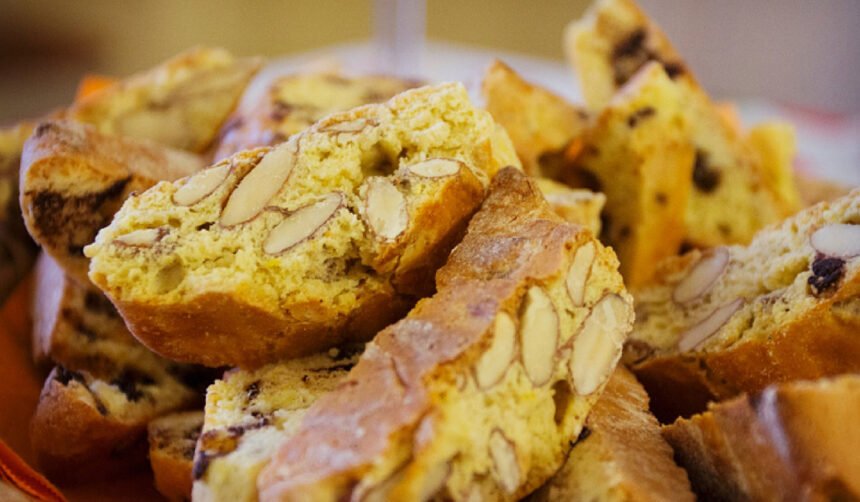What is Бишкоти ди Прато?
Бишкоти ди прато, known internationally as biscotti di Prato, are traditional twice-baked almond biscuits from the Tuscan city of Prato, Italy. The name translates directly to “biscuits of Prato,” and these golden, crunchy treats have become synonymous with both Italian culinary tradition and global dessert culture. Although the word “biscotti” in Italian simply means “cookies,” outside Italy it typically refers to these specific oblong, nut-studded biscuits that are baked twice for firmness and shelf stability. Unlike soft cookies, бишкоти ди прато are dry, crisp, and purposefully sturdy to be enjoyed with a hot drink or sweet wine. Their signature almond flavor and elegant crunch have made them a popular choice across homes, cafés, and fine-dining establishments around the world.
Historical Origins – From Prato to the World
The story of бишкоти ди прато begins in medieval Tuscany, particularly in the commercial and cultural city of Prato. As early as the 14th century, local bakers discovered that baking biscuit dough twice created a dry, long-lasting snack suitable for travel, trade, and storage. These twice-baked cookies, initially created out of necessity for durability, quickly became associated with everyday Italian life and festive occasions. However, it was in the 19th century that their legacy was cemented when Antonio Mattei, a famous Prato baker, formalized the modern version of the recipe. His version excluded fat, used whole almonds with their skins, and became so iconic that it is still sold in distinctive blue paper packaging from the Mattei bakery. As Italian immigrants spread across the globe, they brought this cherished recipe with them, making бишкоти ди прато a staple not only in Tuscany but also in bakeries and households across Europe, North America, and beyond.
Traditional Recipe – The Original Biscuit of Prato
Core Ingredients
The beauty of бишкоти ди прато lies in its simplicity. The traditional recipe uses only a handful of ingredients: flour, sugar, eggs, and whole almonds—often unpeeled to maintain a rustic and authentic look. Some versions may include pine nuts or a touch of citrus zest, but the original version remains true to the principle of minimalism. Importantly, there is no butter, oil, or leavening agents like baking soda or powder in the original recipe, making the biscuits naturally low in fat and beautifully dry in texture. These core ingredients are mixed in just the right proportions to form a dough that bakes into firm logs, ready for the double-baking process that gives them their distinctive crunch.
Step-by-Step Instructions
To prepare authentic бишкоти ди прато at home, start by mixing eggs and sugar until the mixture becomes light and fluffy. Then gently fold in flour and a pinch of salt to form a thick dough. Add toasted whole almonds to the mix, ensuring they are evenly distributed. Shape the dough into long, flat logs and place them on a parchment-lined baking sheet. Bake the logs at 180°C (350°F) for about 25 minutes, or until golden and firm. Let them cool slightly before slicing them diagonally into thick biscuits using a serrated knife. Arrange the slices cut-side down and return them to the oven for a second bake at a slightly lower temperature for about 10–15 minutes on each side. This second bake is crucial as it removes any residual moisture, giving бишкоти ди прато their classic dry, crisp texture and making them perfect for long-term storage.
The Art of the Double-Bake – Biscotti’s Signature Technique
The unique appeal of бишкоти ди прато comes from the process of double baking. The first bake firms up the dough and sets its shape, while the second bake—done after slicing the logs—drives out moisture to create a hard, crunchy texture that resists spoilage. This technique not only gives biscotti their iconic snap but also allows them to last for weeks without preservatives. The resulting dryness makes them ideal for dipping into beverages like Vin Santo, espresso, or tea. In fact, their very design encourages pairing with a liquid, which softens the biscuit and releases the flavors of toasted almonds, eggs, and flour. The double-bake is not just a cooking method—it’s a cultural choice that reflects the practicality and elegance of Tuscan baking tradition.
Taste, Texture, and Aroma
Бишкоти ди прато offer a flavor and sensory experience that is uniquely satisfying. The taste is subtly sweet, with the rich nuttiness of roasted almonds taking center stage. The lack of butter or oil allows the pure flavors of eggs and toasted flour to shine through, while additions like lemon zest or anise can offer aromatic complexity without overpowering the biscuit. The texture is dry and crunchy, yet not too hard to enjoy—perfect for dunking. When fresh from the oven or slightly warmed, these biscuits emit a comforting aroma of almonds and baked dough, reminiscent of Italian kitchens and cozy bakeries. Their flavor and texture combination make them ideal as a standalone treat or as a complement to other foods and drinks.
Variations on the Classic Recipe
Traditional Twists
Although the original version with whole almonds remains the gold standard, there are a few traditional twists that are still considered authentic. Some bakers in Tuscany add pine nuts for a different texture, or use anise seeds for a light licorice note. Others include lemon or orange zest to add a bright aroma and a touch of citrus tang. These variations still maintain the fundamental structure of бишкоти ди прато—no added fat, twice baked, and built for flavor and preservation.
Modern Innovations
In recent years, creative bakers around the world have given бишкоти ди прато a contemporary makeover. Chocolate-dipped biscotti are now common in cafés and gift boxes, while pistachios, hazelnuts, and even macadamia nuts are used as alternatives to almonds. Dried fruits like cranberries, cherries, and apricots are added for both sweetness and visual appeal. Vegan versions substitute eggs with aquafaba or flaxseed gel, and gluten-free renditions use rice flour or almond meal. Health-conscious consumers enjoy sugar-free or honey-sweetened biscotti that still retain the essential crunch and elegance of the original.
Бишкоти ди Прато in Italian Culture
Бишкоти ди прато is more than just a dessert in Italy—it is a cultural symbol of hospitality, celebration, and culinary heritage. In Tuscany, it is customary to serve these biscuits with Vin Santo at the end of a meal, a tradition that dates back generations. Sharing biscotti and wine with guests is a gesture of warmth and respect, often reserved for special occasions like weddings, holidays, or Sunday family lunches. The iconic Mattei bakery in Prato remains a cultural landmark, with its blue paper-wrapped packages representing both authenticity and pride. These biscuits appear not only on dinner tables but also in literature, art, and even modern Italian cinema as symbols of tradition, community, and togetherness.
Global Popularity – From Prato to Cafés Worldwide
Thanks to globalization and the rise of coffeehouse culture, бишкоти ди прато has found a second home far beyond Tuscany. In the 1990s, biscotti became a staple in American cafés, particularly as espresso culture took hold. Their long shelf life and ability to pair well with coffee made them a favorite among baristas and customers alike. Today, they are sold in supermarkets, gourmet shops, and online stores around the world, often marketed as premium or artisanal goods. Countries like France, the U.S., and even Japan have embraced their own localized versions, adding regional flavors while respecting the core method. This global presence has elevated бишкоти ди прато from a Tuscan tradition to a universal dessert icon.
Health Benefits and Nutritional Profile
Compared to richer desserts like cakes and cream-filled pastries, бишкоти ди прато is a lighter, more nutritious option. Its lack of butter or oil means lower saturated fat, and the inclusion of almonds offers heart-healthy fats, fiber, protein, and important micronutrients like Vitamin E. One or two pieces typically provide a satisfying snack without excessive calories, making them ideal for portion control. Homemade and modern versions can reduce sugar content or use natural sweeteners like stevia or honey, making them accessible to diabetic or health-conscious consumers. While they remain a treat, their clean ingredient list makes them one of the more wholesome options in the dessert category.
Pairing Suggestions – Drinks and Dips
Бишкоти ди прато are famously known for their ability to pair beautifully with beverages. The most traditional pairing is with Vin Santo, a sweet dessert wine from Tuscany. The wine’s syrupy texture and nutty flavor complement the dry, almond-rich biscotti perfectly, softening them just enough to release their full aroma. For modern drinkers, espresso and cappuccino are excellent choices. The bitterness of the coffee contrasts with the subtle sweetness of the biscuit, creating a balanced flavor. Tea lovers can dip biscotti into black or herbal teas, especially chamomile or rooibos. Some adventurous pairings include dessert liqueurs, spiced cider, or even ice cream affogato-style for a sophisticated dessert twist.
Baking Бишкоти ди Прато at Home – DIY Guide
Making бишкоти ди прато at home is both simple and rewarding. All you need is a few basic ingredients, a baking tray, a mixing bowl, and a sharp serrated knife. After preparing and double-baking the dough as described earlier, store the cooled biscuits in an airtight tin or glass jar to keep them fresh for weeks. If you plan to freeze them, place them in a sealed freezer-safe bag and thaw at room temperature before serving. To avoid crumbling when slicing, let the logs cool slightly and use a gentle sawing motion with a sharp knife. Space them well on the tray during the second bake to allow air circulation for even crisping. Baking at home allows full control over ingredients and opens the door to personalizing this classic with your own twist.
Бишкоти ди Прато in Business & Marketing
Бишкоти ди прато has become a hallmark of artisanal baking and Italian culinary branding. Many bakeries and food brands use it to signal quality, tradition, and craftsmanship. Its association with Tuscany and old-world charm makes it a popular gift item, often presented in elegant tins or seasonal boxes. In 2025, brands focus on themes like local sourcing, sustainable packaging, and modern dietary needs (e.g., gluten-free or organic). Online platforms allow bakers to ship internationally, and collaborations with coffee companies or wine merchants help promote cross-selling opportunities. The dual nature of biscotti—both everyday and luxury—makes it a unique product in today’s food market.
Cultural Identity and Tourism
For tourists visiting Tuscany, sampling authentic бишкоти ди прато is often high on the list. Bakeries in Prato offer tastings, factory tours, and even workshops for travelers interested in learning the art of traditional biscotti-making. These experiences go beyond food—they connect visitors to the culture, people, and spirit of the region. Culinary tourism has turned these biscuits into ambassadors of Tuscan identity, drawing food lovers and storytellers from around the world. Whether enjoyed on a cobblestone street in Italy or gifted in a holiday hamper, biscotti carries a piece of that cultural richness with it.
Contemporary Culinary Usage
Beyond being a standalone biscuit, бишкоти ди прато is now featured in modern desserts and plated presentations. Chefs crumble it into tiramisu layers, serve it with cheese boards, or offer it as a crunchy element in deconstructed desserts. It can be blended into parfaits, used as crust for cheesecakes, or even paired with sorbet and gelato for texture contrast. Its versatility and elegant simplicity make it a favorite in both home kitchens and fine-dining establishments, where tradition meets creativity.
Challenges and Preservation of Authenticity
As the global popularity of бишкоти ди прато grows, there’s also a risk of losing its authenticity. Mass production, over-sweetening, and soft textures introduced for convenience can dilute the original concept. Many commercial versions no longer follow the fat-free, twice-baked model. Culinary historians and artisan bakers in Italy continue to advocate for protecting the traditional method, emphasizing the importance of regional ingredients and time-tested techniques. Initiatives like “Slow Food” and regional certifications are helping preserve these recipes for future generations.
Future of Бишкоти ди Прато
Looking ahead, бишкоти ди прато is set to evolve while staying true to its roots. We can expect more gluten-free, organic, and allergy-friendly options as consumer preferences shift toward health and sustainability. Digital platforms like YouTube, Instagram, and TikTok are making traditional recipes more accessible, especially for younger audiences. Food influencers, chefs, and AI-generated recipes are helping reinvent biscotti in exciting ways without erasing its heritage. As a result, by 2030, this classic Tuscan treat will likely remain a cultural and culinary staple—part ancient tradition, part modern favorite.
Conclusion
Бишкоти ди прато is more than a biscuit—it is a story baked into every slice. It embodies the practicality of medieval Tuscan bakers, the refinement of Italian cuisine, and the emotional connections we build through shared food traditions. From a humble preservation solution to a globally cherished delicacy, biscotti’s journey is nothing short of remarkable. Its texture, flavor, and meaning transcend borders, offering both comfort and elegance in every bite. Whether enjoyed with Vin Santo in Prato or espresso in New York, бишкоти ди прато continues to connect cultures, generations, and palates—one crunchy bite at a time.
FAQs About Бишкоти ди Прато
1. What is бишкоти ди прато?
Бишкоти ди прато is a traditional Italian biscuit from the city of Prato in Tuscany. It is a twice-baked cookie made with almonds, flour, sugar, and eggs. These biscuits are dry, crunchy, and often enjoyed by dipping them into coffee or sweet wine like Vin Santo.
2. Why is бишкоти ди прато baked twice?
Бишкоти ди прато is baked twice to make it crisp and long-lasting. The first bake gives it shape, and the second bake removes moisture, making it dry and perfect for dipping into drinks without falling apart.
3. How do you eat бишкоти ди прато the traditional way?
Traditionally, you eat бишкоти ди прато by dipping it into Vin Santo, a sweet dessert wine from Tuscany. This softens the biscuit slightly and brings out its almond flavor. It can also be enjoyed with coffee, tea, or hot chocolate.
4. Can I make бишкоти ди прато at home?
Yes, you can easily make бишкоти ди прато at home using basic ingredients like flour, sugar, eggs, and almonds. You bake the dough twice—first as logs, then sliced into cookies—for that crunchy texture.
5. Is бишкоти ди прато a healthy dessert?
Бишкоти ди прато is healthier than many desserts because it contains no butter or oil. Almonds add protein and healthy fats. It’s a light, crunchy snack when eaten in moderation, especially with coffee or tea.
You May Read Also: Lufanest Revolution: The Powerful Digital Shift You Can’t Ignore
For More Information, Visit Dotmagazine









